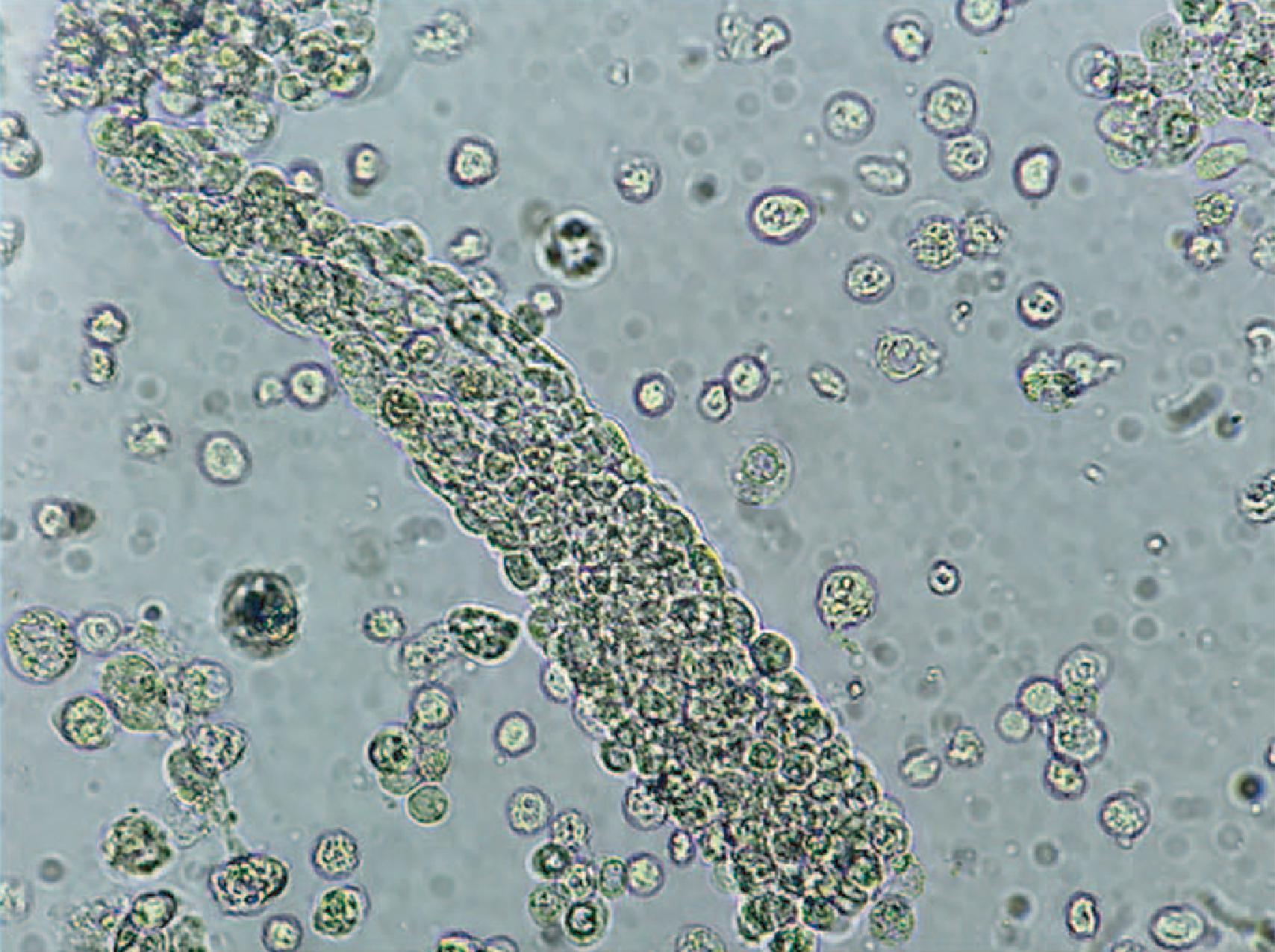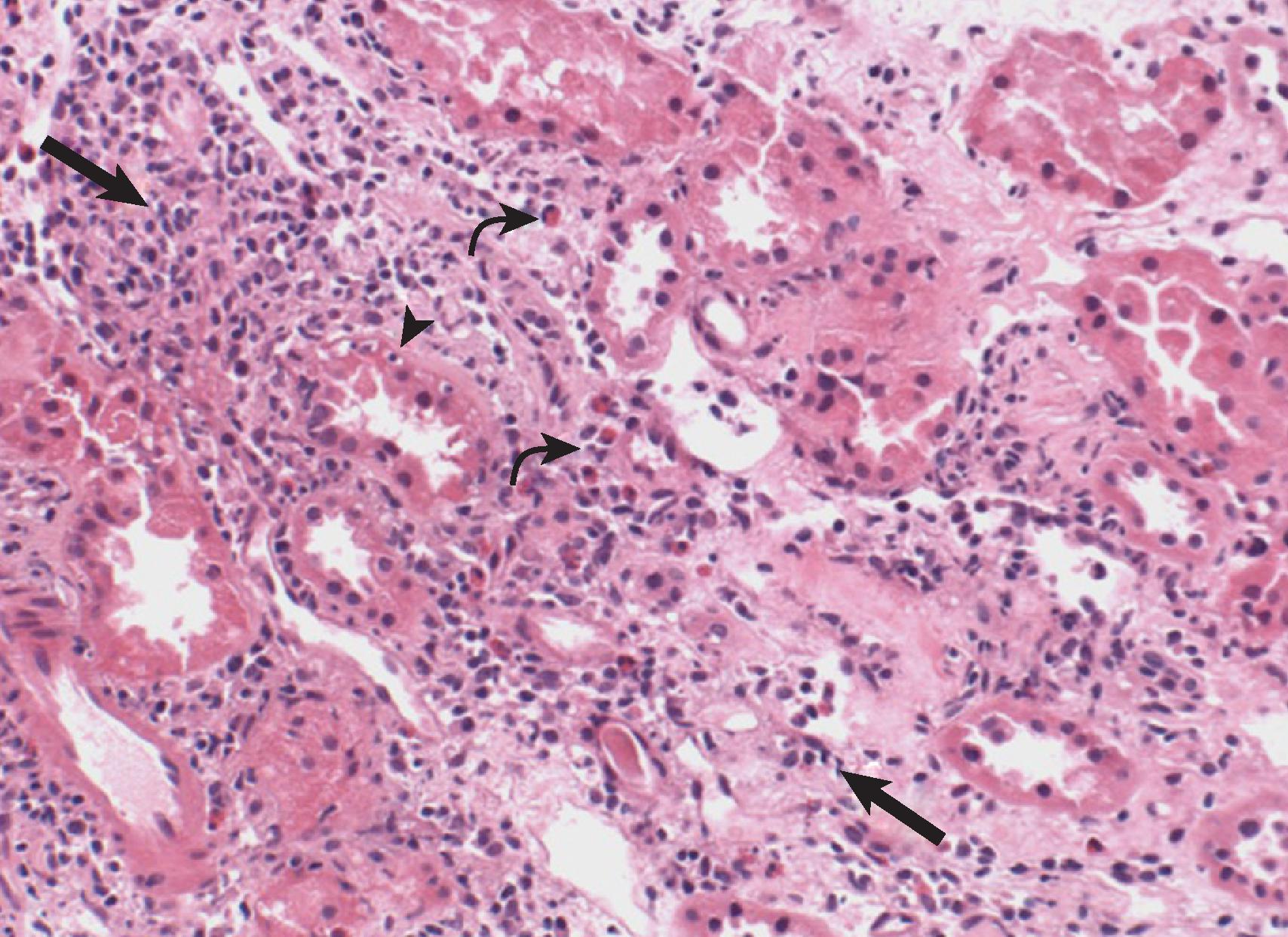Physical Address
304 North Cardinal St.
Dorchester Center, MA 02124
In 1898, W. T. Councilman defined acute interstitial nephritis (AIN) as “an acute inflammation of the kidney characterized by cellular and fluid exudation in the interstitial tissue, accompanied by, but not dependent on, degeneration of the epithelium; the exudation is not purulent in character, and the lesions may be both diffuse and focal.” This was seen on postmortem examination of patients with scarlet fever and, less commonly, other systemic infectious diseases that had no evidence for direct bacterial invasion of the kidney parenchyma.
More than a century later, definitive diagnosis of AIN requires the pathologic findings of interstitial edema and infiltration with acute inflammatory cells, including polymorphonucleocytes (PMNs), eosinophils, and lymphocytes. In the years since Councilman's description, the causes of AIN have changed dramatically, with pharmacologic agents now being the most common etiology (more than 75%). In this chapter we will focus primarily on acute tubulointerstitial inflammation, while briefly covering direct parenchymal invasion by infectious agents.
The incidence of AIN varies greatly, depending on the clinical scenario. An incidence of 0.7% is seen in asymptomatic patients with proteinuria or hematuria, whereas hospitalized patients with acute kidney injury (AKI) of unknown etiology experience an incidence of 10% to 15%. Although AIN can occur in all age groups, it is more common in the elderly. In one report, biopsy-proven AIN was seen in 3.0% of the elderly compared with 1.9% of younger subjects. This may reflect greater exposure of elderly patients to drugs and other inciting factors.
The presenting symptoms of AIN include an acute or subacute decline in kidney function, often in patients exposed to multiple drugs. Although the “classic” presentation of skin rash, arthralgia, and eosinophilia is occasionally seen, this triad occurs in only 5% to 10% of unselected patients. This presentation more commonly occurs in association with certain drugs, such as penicillin derivatives, compared with nonsteroidal antiinflammatory drugs (NSAIDs). Fever, the most common clinical sign, is present in up to 50% of patients with drug-induced AIN but only in 30% of unselected patients. Skin rash is reported in one-third of patients and is usually maculopapular or morbilliform, typically involving the trunk. More often, a rash is seen when AIN is related to a drug hypersensitivity reaction. No clinical symptoms or signs are sensitive or specific enough to establish a definitive diagnosis. Nonoliguric AKI usually accompanies AIN, but oliguric AKI with a rapid rise in creatinine also occurs. Increasingly, AIN develops in patients with underlying chronic kidney disease (CKD) and multiple comorbidities, which make a diagnosis challenging. AIN should, therefore, be considered in any patient with acute or subacute decline in kidney function with no clear inciting factor.
Common laboratory findings in AIN are summarized in Table 33.1 . The most frequent abnormality is a slow and steady decline in the glomerular filtration rate (GFR). When dealing with drug-induced AIN, the GFR typically falls 7 to 10 days after starting the medication. Rapid and fulminant presentation of AIN occurs less often, unless there has been previous drug exposure. However, drugs such as the NSAIDs and proton pump inhibitors (PPIs) may not develop AIN for many weeks or months after initial exposure. The time course for AIN related to systemic disease, metabolic disturbances, or infection is more varied and prolonged. Other major laboratory findings include eosinophilia, eosinophiluria, and urinary sediment abnormalities. Eosinophilia is common in β-lactam antibiotic–associated AIN, reported in up to 80% of cases, where only one-third of other drug-induced AIN cases develop eosinophilia. Hyperkalemia, with or without hyperchloremic metabolic acidosis, is occasionally seen. Other tubulopathies may rarely occur. Anemia is also commonly described in AIN. This finding is rather nonspecific, especially in the setting of systemic inflammation, AKI, or underlying CKD. Anemia with AIN is most likely the result of decreased erythropoietin production from the medullary interstitium and underlying erythropoietin hyporesponsiveness in the setting of inflammation or infection.
| Eosinophilia | Inconsistent Finding Seen More Commonly in Drug-Induced AIN |
| Eosinophiluria (>1% and >5%) | Sensitivity 19.8%–30.8%, specificity 68.2%–91.2%, PPV 15.6%–30%, NPV 83.7%–85.6%, positive LR 0.97–2.3, negative LR 0.9–1.01 |
| Urinary sediment | Hematuria, leukocyturia, leukocyte casts, RTE cells, and RTE casts |
| Protein excretion | Less than 1 g/24 hours |
| Fractional excretion of sodium (FeNa) | Greater than 1% |
| Proximal tubular defect | Glycosuria, phosphaturia, bicarbonaturia, aminoaciduria |
| Distal tubular defect | Hyperkalemia, distal RTA, sodium wasting |
| Medullary defect | Nephrogenic diabetes insipidus, anemia |
Urinalysis and the examination of the urine sediment are often the most useful laboratory tests. Low-grade proteinuria (1−2+) and positive leukocyte esterase are noted on urine dipsticks in most patients. Leukocyte esterase has been noted to be positive in approximately 80% of patients with AIN, but ranges from 20%–80% in published studies. Quantitative proteinuria measurements are usually less than 1 g/day, with the majority being non-albumin proteinuria. (Albuminuria would be more indicative of glomerular disease.) Macroscopic hematuria is rare, whereas microscopic hematuria is present less than 50% of the time. Leukocytes are present on urine microscopy in virtually all cases of methicillin-induced AIN but may be absent in as many as 50% of patients with AIN due to other drugs. The absence of leukocyturia, therefore, should not rule out this diagnosis. Classically, urine microscopy will show hematuria, leukocyturia, leukocyte casts, and renal tubular epithelial (RTE) cells ( Fig. 33.1 ). However, urinary leukocyte casts are an insensitive test for diagnosing AIN. Red blood cell casts and mixed red blood cell and white blood cell casts have also been reported. Cellular casts are seen in most cases of methicillin-associated AIN, and in up to 50% of patients with AIN from other exposures. However, up to 20% of AIN cases can have a bland urinary sediment.

Eosinophiluria, once thought to be a hallmark of this disease, is neither sensitive nor specific and should not be used to make a diagnosis. When using a cutoff of greater than 1% urinary eosinophils, the sensitivity and specificity are 30.8% and 68.2%, respectively. A 5% urinary eosinophil cutoff increases specificity to 91.2% but decreases sensitivity to 19.8%. Various techniques used to stain urine for eosinophils and enhance detection (Wright stain and Hansel stain) have proven unreliable and cumbersome. In addition, other disease states, such as cystitis, pyelonephritis, atheroembolic kidney disease, and rapidly progressive glomerulonephritis may present with eosinophiluria, highlighting the poor specificity of this test.
Recent studies have looked at the role of urinary biomarkers, including soluble C5b-9, tumor necrosis factor-α (TNF-α), and interleukin-9 (IL-9) in the diagnosis of AIN. Urinary TNF-α and IL-9 were highly sensitive and specific in differentiating biopsy-proven AIN from other kidney lesions (in particular, acute tubular injury/necrosis) diagnosed on kidney biopsy. While these biomarkers are not currently clinically available, they raise the possibility of future noninvasive methods of diagnosing AIN.
Kidney ultrasound in the setting of AIN typically shows normal to enlarged kidneys with normal echogenicity. However, these findings are also nonspecific and may be seen with other forms of kidney disease. Although a gallium-67 scan was initially reported as highly sensitive in AIN, this has not been supported over time, and its only role may be to differentiate AIN from acute tubular necrosis (ATN) in those patients who cannot undergo a kidney biopsy. Positron emission tomography has shown diagnostic promise in several AIN cases but needs further evaluation before widespread use.
Although suspicion of AIN is based on clinical clues, definitive diagnosis often requires a kidney biopsy. Major pathologic findings include interstitial edema, inflammation, and tubulitis without glomerular or vascular involvement ( Fig. 33.2 ). Interstitial infiltration may be diffuse but is often patchy in nature and consists of lymphocytes, mononuclear cells, eosinophils, neutrophils, and plasma cells. T lymphocytes are primarily composed of CD4 and CD8 cells. The number of eosinophils is highly variable and is more prominent in drug-induced AIN. Granulomas are uncommon but occasionally seen, especially with sarcoidosis and drug-induced AIN. Tubulitis, characterized by the invasion of inflammatory cells through the tubular basement membrane, results in tubular injury and is often seen in association with severe inflammation. The severity of interstitial inflammation, however, does not always correlate with clinical outcome. Poor prognosis is more directly related to the degree of interstitial fibrosis and tubular atrophy. Immunofluorescence and electron microscopic studies are usually unrevealing. NSAID-related AIN is sometimes associated with glomerular features of minimal change disease or membranous nephropathy. In contrast to isolated AIN, full-blown nephrotic syndrome accompanies AKI in NSAID-related cases.

The clinical and histopathologic findings summarized earlier strongly point to an immune-mediated mechanism initiating and sustaining tubulointerstitial damage. The immunologic basis of injury is supported by the low frequency of AIN in persons exposed to a drug, lack of dose dependency, presence of systemic symptoms in some patients, and recurrence of AIN upon re-exposure. The antigens initiating the immune-mediated injury could be of endogenous origin (Tamm-Horsfall protein, megalin, and tubular base membrane components) or exogenous, such as drugs and chemicals. Exogenous antigens may be trapped directly or may circulate as immune complexes that are deposited in the kidney interstitium. They may bind to a tubular antigen acting as a hapten or mimic a normal tubular or interstitial antigen, thereby triggering an immune reaction. In animal models, both cell-mediated and humoral immunity is involved. The injury is initiated by the presentation of endogenous or exogenous antigens to antigen-presenting lymphocytes, resulting in the activation of T cells. These cells induce differentiation and proliferation of other T cells responsible for delayed hypersensitivity and cytotoxicity. The resultant inflammatory infiltrates within the interstitium produce a variety of fibrinogenic cytokines and chemokines, such as transforming growth factor-β (TGF-β), platelet-derived growth factor-BB (PDGF-BB), epidermal growth factor (EGF), and fibroblast growth factor-2 (FGF-2). The fibroblasts invading the interstitium are the product of epithelial-to-mesenchymal transition. Ultimately, this inflammatory process results in the accumulation of extracellular matrix, interstitial fibrosis, and tubular loss.
NSAID-induced interstitial nephritis appears to have a different mechanism of action. NSAIDs inhibit cyclooxygenase-1 and cyclooxygenase-2, enzymes that catalyze the conversion of arachidonic acid into prostaglandin H2. When this reaction is inhibited, arachidonic acid can then be converted preferentially to leukotrienes through the action of lipoxygenase. This results in an imbalance of inflammatory mediators with an abundance of the proinflammatory leukotrienes and a paucity of prostaglandins, which serve to regulate the inflammatory cascade.
There are multiple causes of AIN, but pharmacologic agents are the most common ( Table 33.2 ). Diagnosis of AIN should trigger a review of the medication list to identify culpable agents and limit further drug exposure. In addition to various drugs, certain infectious agents may induce AIN. Although less common in the antibiotic era, infectious agents must be considered when the clinical scenario is consistent. Finally, systemic diseases, primarily rheumatologic, are associated with the pathologic findings of AIN. These diseases are usually evident from the clinical presentation ( Table 33.3 ).
| Drug Class | Examples |
| Antibiotics | β-lactams, sulfonamides, fluoroquinolones, rifampin, vancomycin, erythromycin, ethambutol, chloramphenicol |
| Antivirals | Acyclovir, atazanavir, abacavir, indinavir |
| Analgesics | NSAIDs, selective COX-2 inhibitors |
| GI medications | PPIs, H2-receptor blockers, 5-aminosalicylates |
| Anticonvulsants | Phenytoin, carbamazepine, phenobarbital |
| Diuretics | Hydrochlorothiazide, furosemide, triamterene, chlorthalidone |
| Anticancer agents | Tyrosine kinase inhibitors, immune-checkpoint inhibitors, B-RAF inhibitors |
| Others | Allopurinol, Chinese herbs |
| Bacterial infection | Legionella, Staphylococcus, Streptococcus, Yersinia |
| Viral infection | Hantavirus, CMV, EBV, HIV, herpes simplex, Hep C, SARS-CoV-2 (?) |
| Autoimmune | Systemic lupus erythematosus, Sjögren syndrome, sarcoidosis, Crohn disease, IgG4 disease |
| Neoplastic diseases | Lymphoproliferative disorders, plasma cell dyscrasias |
Become a Clinical Tree membership for Full access and enjoy Unlimited articles
If you are a member. Log in here